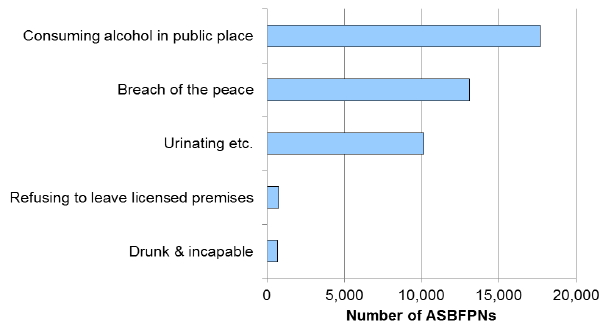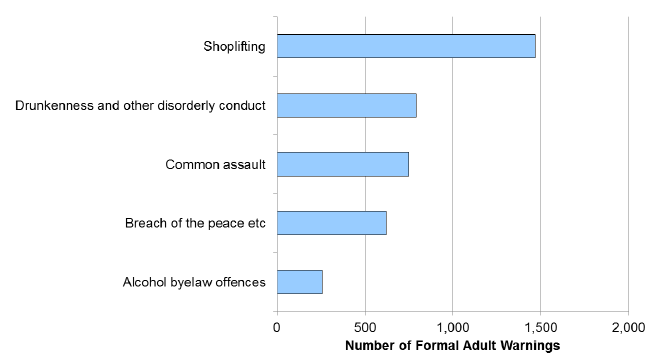CRIMINAL PROCEEDINGS IN SCOTLAND 2014-15
Summary of offences dealt with by courts, sentencing outcomes and characteristics of convicted offenders. Additional information on non-court penalties issued by the Police and Crown Office & Procurator Fiscal Service.
14. Police Disposals
This section outlines detail on some of the measures available to the police for dealing with minor offences. Statistics are presented on anti-social behaviour fixed penalty notices (ASBFPNs), formal adult warnings and actions used specifically for juveniles (aged 8 to 17) such as restorative justice warnings and Early and Effective Interventions (EEI).
ASBFPNs make up the vast majority of police disposals presented in this publication. It is important to note, however, that there are other types of police measures not included such as fixed penalty notices for moving motor vehicle offences and other youth justice measures. A full listing of the range of disposals available to the police can be seen in Annex D.
Anti-Social Behaviour Fixed Penalty Notices (ASBFPN)
Anti-Social Behaviour Fixed Penalty Notices (ASBFPNs) allow the police to issue offenders a £40 fine for a range of offences including drunken-related behaviours and playing loud music. In 2014-15, 42,933 people received an ASBFPN as a main penalty, a decrease of 23 per cent from 55,562 in 2013-14.
The recent decrease comes after a period of relative stability in the number of ASBFPNs issued over the previous 4 years (ranging between 53,700 to 55,500 per annum). It is thought that some of the decline in the use of ASBFPNs may be linked to Police Scotland recently issuing guidance to emphasise the Lord Advocate’s guidelines relating to ASBFPNs. These guidelines state that repeated similar offences by the same individual should be referred to the COPFS rather than being dealt with using multiple ASBFPNs.
Chart 14: Most common offences for Anti-Social Behaviour Fixed Penalty Notices (ASBFPNs), 2014-15

In 2014-15 the vast majority of ASBFPNs were issued for three offence types
- 17,646 for consuming alcohol in a public place (41 per cent of total);
- 13,096 for breach of the peace (31 per cent); and
- 10,130 for urinating etc. in circumstances causing annoyance to others (24 per cent).
Males received 85 per cent of all ASBFPNs in 2014-15 (36,612 people) with the most common offences being for consuming alcohol in a public place (41 per cent of ASBFPNs issued to males) followed by urinating etc (27 per cent). ASBFPNs issued to females (6,320 people in total) were primarily issued for breach of the peace (45 per cent of ASBFPNs to females) and consuming alcohol in a public place (43 per cent).
Formal adult warnings
Formal adult warnings (FAWs) are given by the police for minor offences wherein a warning letter is issued to the offender. Police FAWs were given as a main penalty to 4,723 people in 2014-15, down by a third (34 per cent) from 7,135 in 2013-14. More than three quarters of the people issued FAWs in 2014-15 received them for four crimes/offences:
- Shoplifting (31 per cent or 1,465);
- Drunkenness and other disorderly conduct (17 per cent or 791);
- Common assault (16 per cent or 748); and
- Breach of the peace (13 per cent or 620)
Chart 15: Most common offences for Formal Adult Warnings, 2014-15

In 2014-15, 59 per cent of people given FAWs as a main penalty were male (2,771 people in 2014-15), a lower proportion in comparison to the 85 per cent of all ASBFPNs given to males. Around one in five males issued FAWs in 2014-15 were given them for drunkenness (619 people). Proportions differ by age with around a third (29 per cent) of males issued a FAW in the over 30 age group receiving them for drunkenness and other disorderly conduct, compared to 7 per cent of under 21s. A further fifth of males issued FAWs were given the penalty for shoplifting (578 people).
In 2014-15 over two fifths of FAWs (45%) issued to women were for shoplifting (887 people). Proportions differed by age with half (50 per cent) of females issued a FAW in the over 30 age group receiving them for shoplifting, compared to a third (32 per cent) for under 21s.
Police disposals for Young people involved in offending
This section provides statistics on the police disposals that specifically target young people, under the age of 18, involved in offending. In an attempt to plug some of the data gaps on youth justice, a methodological change was implemented to provide statistics on Early and Effective Interventions (EEIs) as recorded on the Criminal History System (CHS). This is the first year these statistics have been published and the section also includes statistics on Restorative Justice Warnings. See Annex B for more detail.
Please note that these statistics are not a full measure of disposals for under 18s as there are a number of other measures managed by the police and other public bodies that we cannot quantify levels for. This is due to the complex nature of how young people involved in offending are dealt with by different organisations and therefore information is captured in different ways on disparate databases.
There are a number of routes for dealing with young people who have offended in Scotland as follows:
- Depending on their age and the nature of the offence some young people who have offended move through the Criminal Justice System in the same way as adults i.e. they are issued a disposal by the police, COPFS or the adult courts. The activity for young people dealt with by these measures is included within the statistics elsewhere in the report.
- Other young people are referred to the Scottish Children’s Reporter Administration (SCRA), which handles the children’s hearing system and provides a safety net to young people involved in offending behaviour rather than exposing them to the adult courts, which can be a damaging experience. The police can use a number of ways to refer individuals to SCRA such as restorative justice warnings, the disposal for which statistics are available. It is important to note that other organisations such as COPFS, social work and educational bodies can also make referrals to SCRA.
- Increasingly the Whole System Approach (WSA) is used to deal with young people aged 8 to 17. This approach was initially piloted from around 2008 and then rolled out across Scotland in 2011 to encourage justice partners to divert young people away from the adult courts and hearing system. One approach used by the police to reduce the unnecessary referrals to the SCRA is Early and Effective Interventions (EEI). The focus of EEIs is to respond as quickly as possible to offending behaviour by children and young people and to put in place rehabilitation support with the aim of reducing the likelihood of reoffending. Practices vary by local authority with a range of agencies (police, education, social work and the third sector) being involved.
Trends in Police Disposals for Young People
In terms of police disposals specifically aimed at young people involved in offending, restorative justice warnings have been in decline from 2,479 people in 2008-09 to 216 people in 2014-15. By contrast the number of young people referred for an EEI increased steadily since their introduction in 2008-09 rising to 650 people by 2011-12. In the two years between 2011-12 and 2013-14 numbers quadrupled to 2,637 people as the use of these practices became more commonplace. In the year to 2014-15 numbers declined slightly, down 4 per cent to 2,533. As outlined above, restorative justice warnings and EEIs are only two of a wide range of interventions the police use to deal with young people involved in offending behaviour so the increase in EEIs may not have directly replaced the number of restorative justice warnings.
Please note that an element of the trend shown may be due to improved recording of EEIs since they were first introduced. This can happen as the new codes become more familiar to the police in terms of recording the information on the CHS and can be an issue when a new disposal is introduced.
Contact
Email: Gillian Diggins
There is a problem
Thanks for your feedback